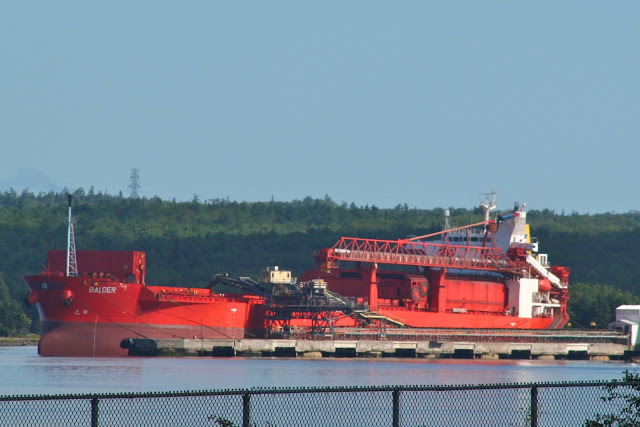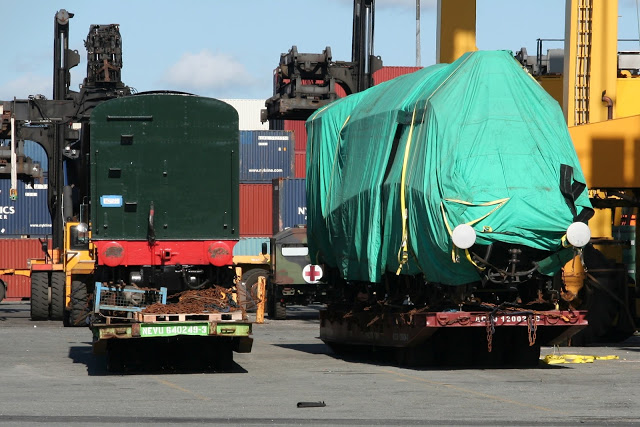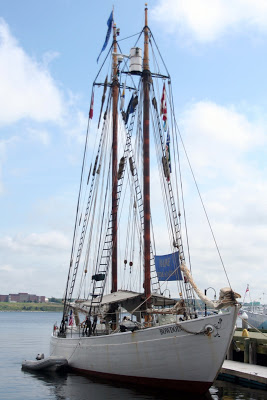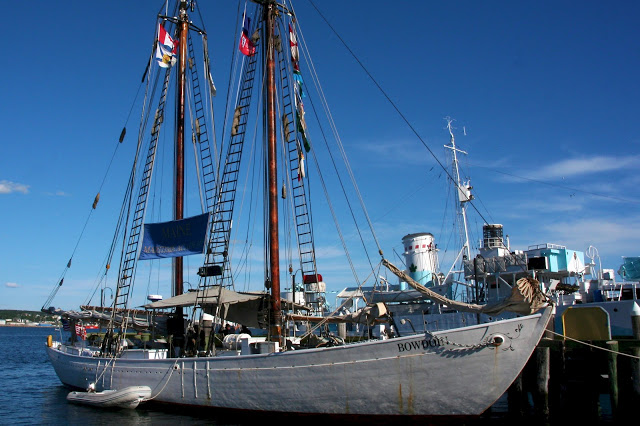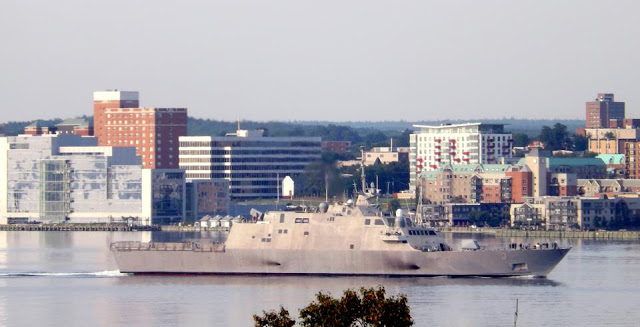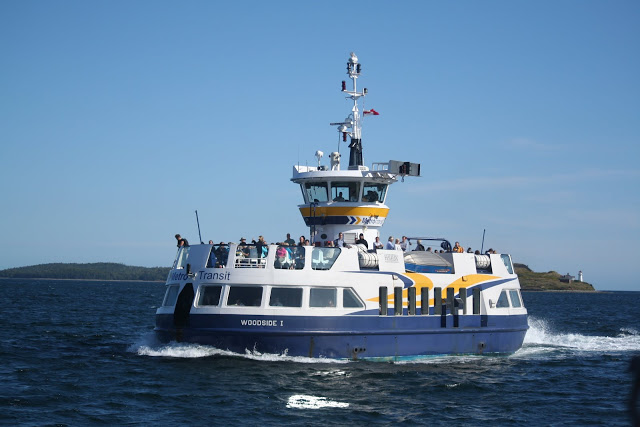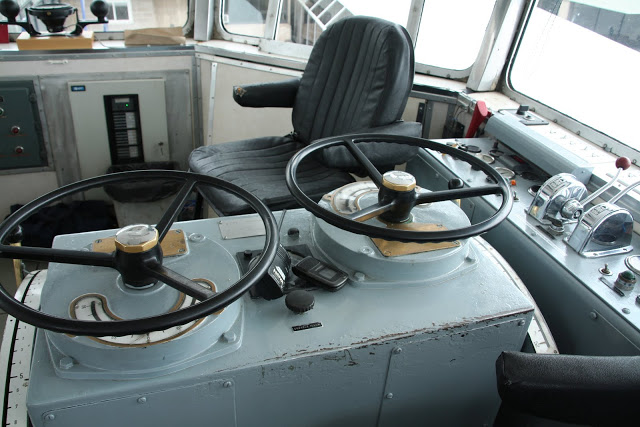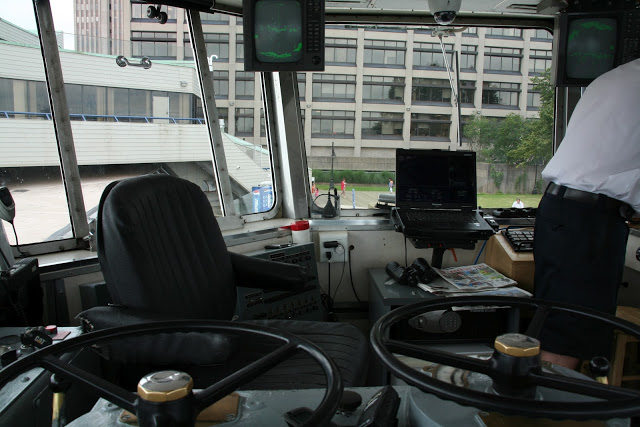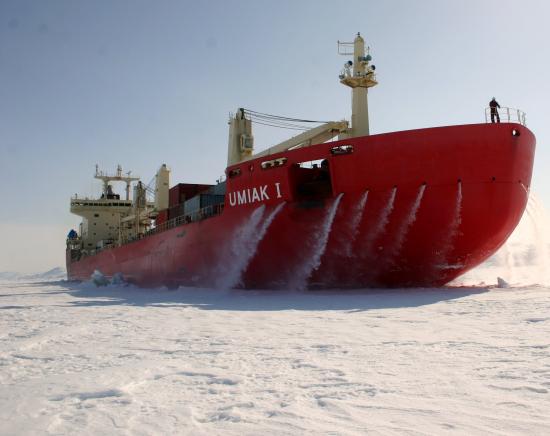Arriving in the fog this morning.
Yearly Archives: 2012
Loading at National Gypsum
Gypsum is one of those products you never think about, but is present in all our lives. Gypsum is a mineral, and is mined heavily in Nova Scotia. Its primary use is the white plaster filling in Wall Board (AKA Dry Wall). Gypsum is mined, and then brought by rail car to National Gypsum on the Bedford Basin, where it is stockpiled, and loaded on to ships.
The Economic downturn was hard on housing, and therefore less wallboard was produced, so less gypsum was as well. Recently An increase in traffic to NAtional gypsum shows that production must Be heading up.
As a bulk commodity, Gypsum is loaded via conveyer into the open holds of the ship. – It is literally poured in. A self unloader makes discharging the cargo relatively fast and easy. Gypsum is a fine poweder, and is not very hard on ships machinery so gypsum carriers can have a long life.
Above – The Bulk carrier Balder Loads Gypsum.
Interesting Cargo for the UK.. More Locomotives
Through The Train Geek I learned that 2 British Steam Locomotives would be returning to England. The First, the Dwight D. Eisenhower arrives on the 19th, and has been transferred to Trailers, presumably to be loaded on a UK Bound ACL Vessel on Monday.
A second Locomotive, The Dominion of Canada will also be returned to England in the coming weeks.
Se the Train Geek Posts Here and Here
Bowdoin returns
The Sailing Vessel Bowdoin Arrived in Halifax for another visit. Bowdoin is the official Sailing Vessel fo the State of Maine, and is used by the Maine Maritime Accademy for Sail trining.
Bowdoin was last in Halifax Last August as well. The Photo At Left is from that Visit.
More Current Photo’s to Follow.
Q is for Quarantine – Carnival Glory and the NoroVirus
The Recent outbreak of Norovirus at a local resturaunt, now seeming to have come from the passengers of the cruise ship Carnival Glory brings up the topic of Quarantine .
Today ships fly the Q flag to indicate that they have not yet cleared customs, However in the past, the Flag was used to indicate that there was an illness aboard ship. Canada has a Quarantine act that applies to marrine traffic.
The Act states: 12.
(1) Where, in the course of a voyage of a vessel to one of the ports referred to in subsection (3), (a) a member of the crew or a passenger on board the vessel has
(i) died,
(ii) had a temperature of 38°C (100°F) or greater that persisted for two days or more or was accompanied or followed by a rash, jaundice or glandular swelling, or
(iii) suffered from diarrhea severe enough to interfere with that person’s work or normal activity,
the person in charge of the vessel shall, by radio at least 24 hours prior to the vessel’s estimated time of arrival at its port of destination and between the hours of 9 o’clock in the forenoon and 5 o’clock in the afternoon, notify the quarantine officer at the quarantine station designated in subsection (3) for that port of the occurrence and provide him with the information described in subsection (2).
(2) The information to be provided to the quarantine officer pursuant to subsection (1) is
(a) the name and nationality of the vessel;
(b) the ports called at during the voyage of the vessel;
(c) the nature of the cargo on board the vessel;
(d) the number of persons comprising the crew of the vessel;
(e) the number of passengers on board the vessel;
(f) the port of destination of the vessel and the name of the vessel’s owner or, if the owner is not in Canada, the name of the vessel’s agent in Canada;
(g) the condition of all persons on board the vessel and details of any death or illness occurring during the voyage;
(h) whether the body of any person is being carried on the vessel;
(i) the estimated time of arrival of the vessel at the port of destination;
(j) the number of persons on board the vessel who are not in possession of valid evidence of immunization to smallpox; and
(k) the date and place of issuance of any de-ratting certificate or de-ratting exemption certificate applicable to the vessel.
(3) For the purpose of subsection (1), the quarantine station for vessels bound for (a) a port in the Province of Nova Scotia or a port in the Province of Prince Edward Island, is Quarantine Station, Halifax, Nova Scotia;
In Halifax, The Quarantine Station is at Anchorage 1, and is identified by the Symbol of a cross in a circle as below:
USS Fort Worth LCS-3
USS Fort Worth arrived this morning and is tied up at “Navy B”, She was built in Wisconsen, and is headed to Texas to be Commissioned.
Update Aug 20:
She is scheduled to Depart at 1500 today.
UPDATE 2: She Failed to Sail as Scheduled. Tim Colton at Maritime Memo’s reports “The word is that LCS 3’s main propulsion diesels are out of action and she’s running on her gas turbines”
Her Stay in Halifax may have been extended due to the propulsion problems.
A View From The Wheel House
Today I was fortunate enough to be invited to cross the harbour from the wheel house of one of our Harbour Ferries. The Dartmouth Ferry is the Oldest Continuously operated salt water Ferry in North America, having gone into service in 1752. The Former City of Dartmouth took over the operation of the Ferry 110 years ago.
The Current Vessels include Dartmouth III and Halifax III Both built in 1979 in Pictou, And the Woodside I Built in 1986 in Pictou. All three ferries are double-ended side-loading, and use two 230 hp Caterpillar model 3306 engines, each driving a model 12E/75 Voith-Schneider propeller. A 4th Ferry of the Same design has been approved for Purchase to improve service on the Halifax-Woodside run.
A Voith-Schneider propeller is like a giant eggbeater, and allows the ferries to move in any direction as well as stop and change direction very quickly. Its controlled via two large steering wheels (one per Drive) that control the blade angle. The operator switches sides so they face forward with direction of travel.
New vessels for ACL
ACL Has ordered new vessels to replace the currrent 4 vessels that call on Halifax.
From the Press Release:
Atlantic Container Line has signed a contract with Hudong-Zhonghua Shipbuilding to build the five largest RORO/Containerships (CONROs) in the world. The G4 (Generation 4) vessels will replace ACL’s existing fleet of G3 CONROs operating in the company’s transatlantic service.
The new vessels will be the first of their type ever built. They will be bigger, faster, greener and more efficient than their predecessors. The G4’s will have a container capacity of 3800 TEUs plus 28,900 square meters of RORO space, with a car capacity of 1307 vehicles. Speed will be increased by 10%, yet fuel consumption per TEU will be reduced by 50%. The new ships will continue to employ cell-guides on deck, a feature that will allow ACL to extend an enviable record: its ships have never lost a container over the side during the last 30 years. All five vessels will be delivered in 2015.
Voisey’s Bay Update
This Summer has seen Tug’s pulling Barge loads of equipment for the New Voisy’s Bay hydromet plant under construction in Long Harbour. When the Plant is completed, the Umiak 1 will begin regular calls in Halifax.
Umiak 1 is a purpose built Ice Class bulk carrier that carries supplies to the Mine, and on the return trip returns with nickel concentrate. I suspect the concintrate will go from the mine, to Long Harbour, then completed product from Long Harbour to Halifax.

